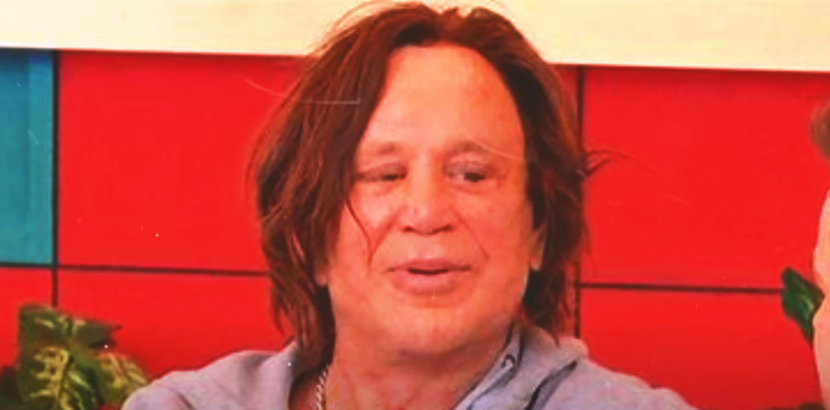Mickey Rourke once ignited a screen rather than merely walking onto it. His presence was subtly defiant, akin to a poet reciting verses with his eyes alone while boxing in shadows. Rourke embodied something exquisitely rough in the 1980s. He wasn’t your typical boy-next-door personality. Rather, he was a complex, wounded, and captivating film enigma. It was more like watching a confession play out in slow motion than watching him perform in Rumble Fish or 9½ Weeks. His face had the texture of vulnerability that few actors dared to display so freely; it was inherently expressive and effortlessly charismatic.
Prior to having his jawline and cheekbones altered by plastic surgery, Rourke’s attractiveness was more than just his appearance; it was his masculine charm, which made flaws seem deliberate. Even before the dialogue started, his unruly hair, faint smirk, and heavy-lidded gaze told tales. Critics frequently praised his “exceptionally layered” emotional range, and many viewers remember his presence as “strikingly real.” His unpolished yet painfully human appearance was exactly what captivated viewers in a time when on-screen authenticity was becoming more and more important.
Mickey Rourke – Biographical and Career Overview
| Attribute | Detail |
|---|---|
| Full Name | Philip Andre “Mickey” Rourke Jr. |
| Date of Birth | September 16, 1952 |
| Birthplace | Schenectady, New York, USA |
| Nationality | American |
| Profession | Actor, Screenwriter, Boxer |
| Years Active | 1979–present (acting), 1991–1994 (boxing) |
| Breakthrough Roles | Diner (1982), Rumble Fish (1983), 9½ Weeks (1986) |
| Famous Post-Surgery Role | The Wrestler (2008) |
| Plastic Surgery Confirmed? | Yes; multiple procedures to fix boxing injuries, later cosmetic enhancements |
| Source | The Independent |
Rourke said, “Most of it was to mend the mess of my face because of boxing,” in an eye-opening interview in 2009. His decision to turn to professional boxing in the 1990s was a sea change for him both physically and professionally. The ring left its mark, causing swelling, shattered noses, and broken cheekbones that changed the very structure of his face. Rourke had several reconstructive surgeries to try to fix those injuries. Unfortunately, some were carried out by the incorrect specialists, resulting in a sequence of operations that eventually drastically altered his face.

By negotiating two hostile environments—Hollywood and boxing—Rourke exposed himself to an uncommon and unrelenting level of scrutiny. His story is reminiscent of the cautionary tales of other celebrities, such as Simon Cowell and Renée Zellweger, who both experienced public backlash after making changes that didn’t meet the expectations of their audiences. But Rourke found the change especially startling. Fans struggled to come to terms with the man who once personified sensitivity and danger becoming a case study in aesthetic loss.
However, public perception changed along with Rourke’s appearance. Once hailed as the next Brando, his popularity at the box office declined as critics questioned his appearance and choices. However, his tenacity has been especially admirable. Even his harshest critics were forced to reconsider his performance when he made a comeback in The Wrestler (2008) because it was so emotionally transparent. In many respects, Randy “The Ram” Robinson’s portrayal of a physically damaged and spiritually tormented man was an autobiography. Rourke took back control of his own story by adopting this fictional persona.
That performance was particularly potent because it reflected the audience’s recollection of Rourke prior to surgery, in addition to being authentic. It was inspired by the depth of emotion he had always possessed but had hidden under public scorn. His performance was hailed by critics as “heartbreakingly raw,” and the film as “surprisingly poetic.” Rourke addressed aging, identity, and redemption through a character who struggles to remain relevant.
His story has sparked a crucial conversation among men in the entertainment industry in recent years regarding cosmetic surgery. In the past, discussions about plastic surgery have primarily centered on female celebrities, unfairly putting older actresses under pressure. However, Rourke’s metamorphosis showed that male actors are not exempt from beauty standards either. The discussion has significantly grown as younger actors like Joe Jonas and Zac Efron deal with comparable rumors.
The social impact is remarkably intricate. Rourke’s openness about his surgeries has been viewed as courageous on the one hand. He provides a unique kind of honesty in a field full of denial by acknowledging procedures and regrets. However, his story has been mishandled, ridiculed, and used as tabloid fodder. This dichotomy brings up significant issues regarding responsibility and empathy. What does aging under a microscope mean? How can we distinguish between public judgment and personal healing?
One theme emerges from all of this: Mickey Rourke was more than just a handsome actor prior to plastic surgery. He was a representation of the human condition’s exquisite contradictions and emotional complexity. And although trauma and time changed how he looked, they never took away his core. He still works and fights for a position in a field that has both benefited and hurt him, sometimes literally and sometimes figuratively.
Rourke’s reputation has significantly improved as a result of his return to roles that value character over appearances. His path could teach today’s actors not only about performance but also about survival. His painful and enlightening past serves as evidence that substance endures while beauty ebbs and flows. His career combines resilience and reinvention in a unique way.
Rourke may no longer look like the person who used to appear in glossy magazines, but at his core, he is still an artist motivated by depth and emotion, much like a sculpture that has been reshaped by time and stress. The ferocity of his contributions and the courage of his vulnerability should never be overshadowed by the discussion surrounding his appearance.
